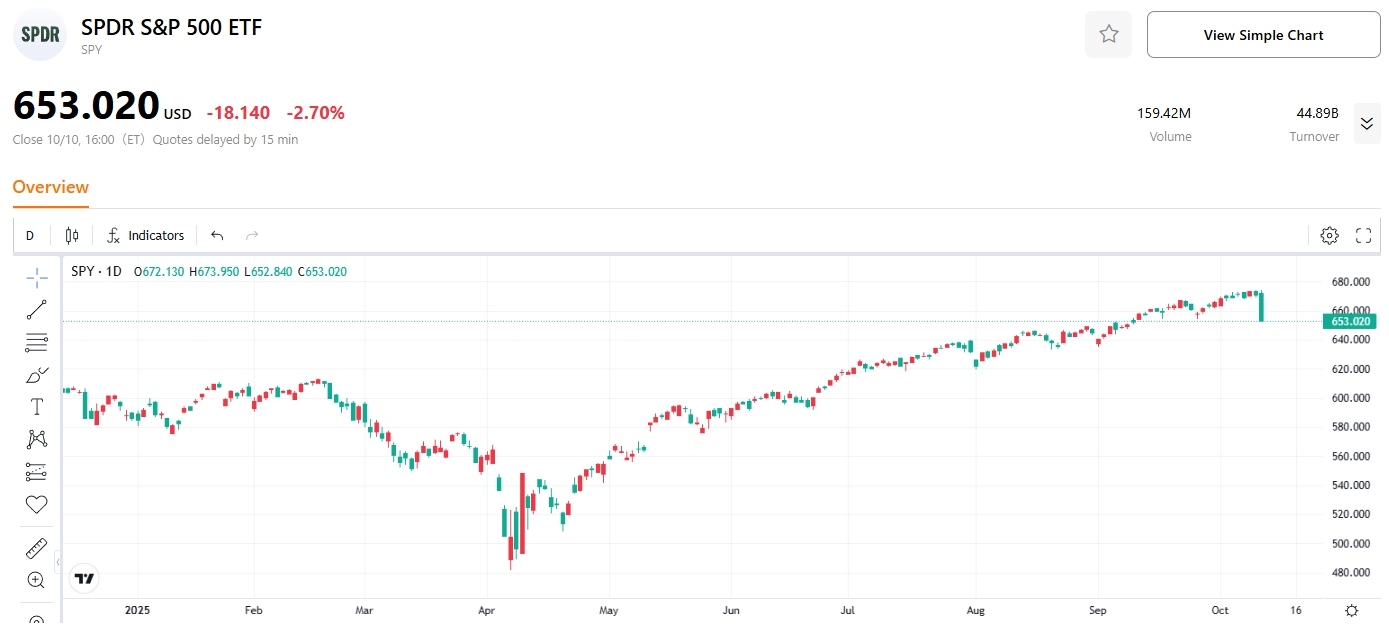What Drove the October 10 Sell-Off in U.S. Stocks? Why Wall Street Isn’t Panicking?
TradingKey - On Friday, October 10, U.S. stocks plunged amid a sudden escalation in U.S.-China trade tensions, echoing the sell-off seen in April. The S&P 500 dropped 2.71% — its largest single-day decline in six months — as investors reacted to renewed fears of a full-blown trade war.
The trigger? President Donald Trump threatened to impose an additional 100% tariff on Chinese imports and canceled plans for a meeting with Chinese President Xi Jinping, shattering months of market calm. The Nasdaq Composite fell 3.56%, also its worst session in half a year, while the VIX volatility index surged 32%.

SPDR S&P 500 ETF, Source: TradingKey
Trade War Flares Up Again
Trump responded aggressively to China’s new export controls on critical materials like rare earth minerals, calling it “holding the world captive.” He declared that his planned meeting with Xi at the APEC summit in South Korea was now “unnecessary” and signaled sweeping new tariffs.
Shortly after the market close, Trump posted on social media:
“The United States of America will impose a Tariff of 100% on China, over and above any Tariff that they are currently paying. Also on November 1st, we will impose Export Controls on any and all critical software.”
This echoes the early-2025 trade war, when the U.S. imposed up to 145% tariffs on Chinese goods and China retaliated with 125% duties — before negotiations cooled tensions. According to the Peterson Institute for International Economics, the average tariff rate on U.S. imports from China now stands at 58%, compared to 37% on Chinese imports from the U.S.
Why Markets Reacted So Sharply
Sam Stovall, Chief Investment Strategist at CFRA Research, said the sudden revival of trade war fears sparked the sell-off. Investors’ biggest concern: that escalating tariffs — combined with softening labor data — could push the U.S. economy into recession.
The sharp drop erased all gains from the week, but major indices remain solidly positive year-to-date:
- S&P 500: Still up 11.41% YTD
- Nasdaq Composite: Up about 15% YTD
Stoval added that he didn’t expect Trump’s comments would be enough to end the bull market.
Dan Greenhaus, Chief Economist at Solus Alternative Asset Management, noted that after headlines about ‘massive increases’ in tariffs, the market clearly went lower. Many investors thought the tariff issue was settled. They had accepted the status quo — but now they may need to reassess.
Wall Street Sees Panic — But Not a Trend
Despite the dramatic reaction, Wall Street analysts are largely unfazed, viewing the selloff as overdone and potentially a buying opportunity.
Societe Generale’s Manish Kabra said that if investors didn’t still expect a deal between Beijing and Washington, today’s sell-off would have been much worse.Kabra added that Treasury yields didn’t spike like during April’s “Liberation Day” crash.
Aptus Capital Advisors pointed out that after one of the strongest six-month rallies in history, volatility triggered by major risks is normal — not a reason to turn bearish.
Citi analysts observed:
“We have not seen a material uptick in selling so far on this news. If anything, we have received incomings on what should be bought on the pullback.”
Allspring Global Investments agreed: short-term volatility from U.S.-China tensions may be inevitable, but it could create attractive entry points, especially given strong fundamentals and corporate earnings in the U.S.
Buy the Dip, Don’t Flee the Market
Wedbush analyst Dan Ives offered the most direct take: This isn’t the prelude to the 1999 dot-com crash — it’s more like the start of the 1996 bull run.
He urged investors to buy quality tech stocks on weakness, rather than flee the market due to political rhetoric.



